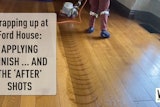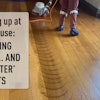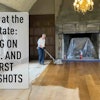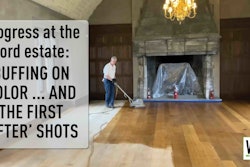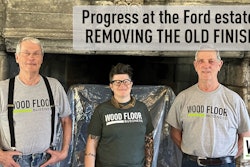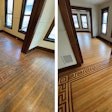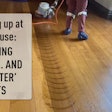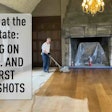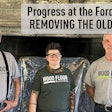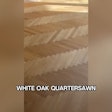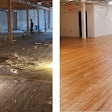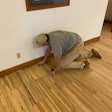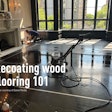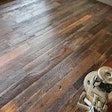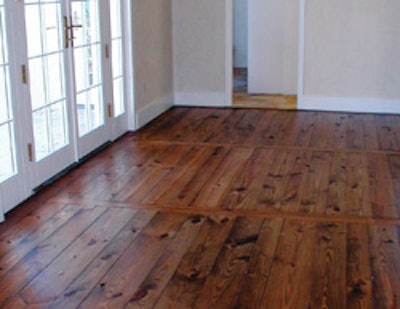
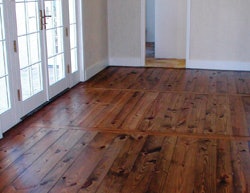
Wax finish is an old-fashioned look for wood floors—the way contractors did it in the old days before the urethanes came out. Through the '40s, '50s and '60s, wax was very popular, and today, it's coming back. Many architects and designers have jumped on the bandwagon of waxed floors, especially because wax goes so well with the hand-scraped and distressed floors that are popular. About 30 percent of my jobs now are waxed floors. Another reason I like a waxed floor is that the homeowner can maintain it themselves. With a prefinished or job-site-finished urethane floor, the homeowner has to call a professional, but the waxed floor can be touched up with a white pad on one of those little rental buffers. And, while some people may disagree, I think a waxed floor is also a very durable floor.
RELATED: What to Know about Wax, Shellac & Other Alternative Finishes
Following are the steps I use to do a waxed floor with two coats of shellac and two coats of wax. The pictures are from a demo I did at the NOFMA/NWFA Wood Flooring Basics School last March, where we did half the panel with paste wax and the other half with liquid wax.

SUPPLY LIST
- shellac (amber or clear)
- denatured alcohol
- natural or dark brown paste wax OR natural or dark brown liquid wax
- lambswool applicator or 6-inch China bristle brush
- rags
- buffer
- 1/4 - or 3/4 -inch white pad
- steel wool (1/0 to 4/0, depending on sheen desired)
- small steel wool pads for edges
- maroon pad
Step 1

Sand the floor as you would to prepare for any finish and apply stain, if desired. Mix shellac and denatured alcohol in a 50/50 mix. Because you're using shellac, take all precautions with any type of electric or gas ignition, and use an OSHA-approved respirator.
Step 2

Apply the mixture with a lambswool applicator or a 6-inch China bristle brush. You'll get about 500 to 700 square feet per gallon of the mixture. The shellac dries quickly, so apply it evenly and at a steady pace. If you aren't used to applying it, practice before doing it on a job (especially with amber shellac), or you'll have streaks and applicator marks all over the floor, and you can't buff them out.
Step 3

Before applying another coat of shellac, buff the floor using a 16-inch steel wool pad (choose the grade depending on the sheen you want) or a maroon pad. Buffing between shellac coats helps eliminate grain raise, bubbles and debris in the finish. You'll need to wait about two hours if drying conditions are good or possibly until the next day (always check the manufacturer's recommendations) before buffing the first coat. Then, clean the floor and apply the second coat of shellac.
Step 4

Now you want to smooth the floor. Use a 16-inch steel wool pad backed with a thick white pad or a maroon pad backed with a thick white pad—either way, you want it to be real forgiving. You'll need to use smaller pieces of the same material by hand at the wall lines. After buffing, clean the floor by vacuuming or sweeping. Then you're ready to apply the wax.
Step 5

You can use either paste wax or liquid wax, just make sure it's a wax made specifically for wood floors, not kitchen wax or bathroom wax (for liquid wax, skip ahead to Step 8).
For paste wax, use cheesecloth or terrycloth white rags like the ones you buy at the hardware store. Whatever you use, the rag should be porous so it allows the wax to flow out evenly. Scoop out a clump of the wax and wrap it up in the rag.
Step 6

For strip or plank floors, rub on the wax in the direction of the flooring. On pattern floors like the fingerblock shown here, rub it in a circular motion. If you rub it straight on parquet, you can leave streaks or lines. Do rows of about 2 feet at a time.
You can either immediately buff in the wax or allow it to dry for one hour (again, check the manufacturer's recommendations). (If you buff it in right away, allow the wax to dry for one to two hours before polishing it.)
Step 7

Use a white pad or a steel wool pad to buff in the wax. What you use—the white pad or the different grades of steel wool—depends on the sheen desired (see "A Few Tips" sidebar below). For a parquet floor, buff it north and south, then east and west. Let the wax dry (about 10 minutes), then buff the floor again to get the lustre you want. Use a clean or new white pad or steel wool pad; you'll need to change it frequently because it loads up (when it does, it just smears the wax rather than polishing it). Skip ahead to Step 10.
Step 8

If you use liquid wax, you can go from Step 4 to this step. Pour out the liquid floor wax, then use a soft terrycloth rag or another rag that will hold a lot of wax.
Step 9

Just as with paste wax, you want to apply the wax straight on strip or plank floors and in a circular motion on parquet floors. Let the liquid wax dry for one to two hours before buffing, or buff it in immediately and then let it dry for one hour before polishing (check the manufacturer's recommendations).
Step 10

Use the buffer to buff in the wax and then to polish it to the desired sheen, as discussed in Step 7. Even if you're going to apply another coat of wax, make sure you get the first coat to the lustre you want. You can always make the floor less glossy on the second coat, but you can't make it more glossy, so keep that in mind when you buff the first coat.
Step 11

Now apply a second coat of whichever type of wax you're using.
Step 12

After the second coat of wax is dry, buff it again to polish it to the desired lustre. Here we're using a white rag that's almost like a flannel material or the inside of a sweatshirt to polish the floor to a semi-gloss sheen. You can also use wool carpeting remnants or a fine or super-fine polishing brush made for the buffer.
Step 13

If the floor is polished out to the sheen you would like and the conditions in the house are good, you can move the furniture back in when you are finished. If it is humid, wait at least 24 hours (always follow the manufacturer's recommendations). Be sure your customer understands how to do spot repairs and maintain the floor.
A Few Tips
Whether you use paste wax or liquid wax is a matter of personal taste; there's a difference in the look of each. Paste wax goes on thicker and you get a faster build, but applying it takes longer. Liquid wax goes on quicker and smoother but also thinner.
You can get a wide variety of colors depending on whether you use clear or amber shellac and natural or dark brown wax. You can also use universal tints that mix with denatured alcohol to affect the color.
You can get dozens of sheens depending on the buffer technique and the material you use. For example, just a white pad will make the floor semi-gloss to shiny. A rougher steel wool like 1/0 will make the floor rougher, while the finer steel wool like 4/0 will make it shiny.











